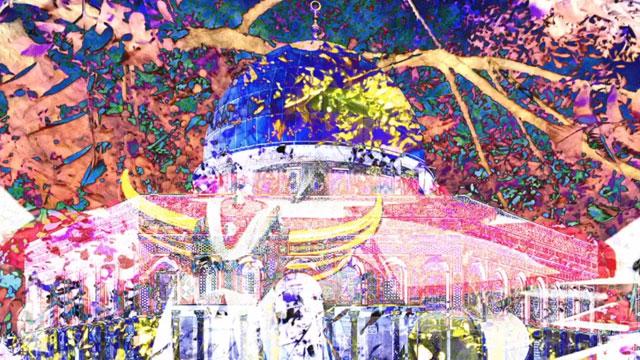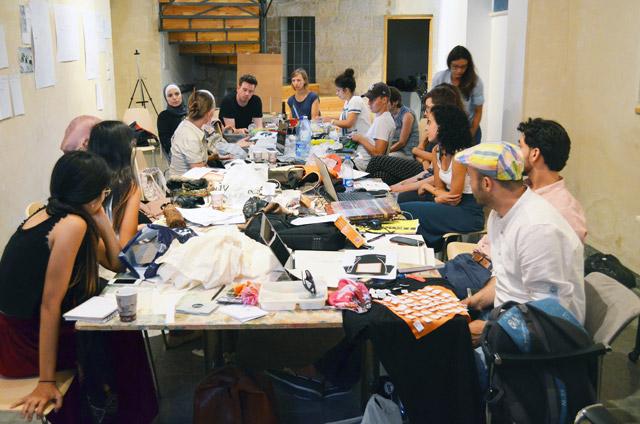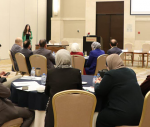You are here
Aesthetics of distress and hope: Two complementary exhibitions showcase Palestine’s rich cultural heritage
By Sally Bland - Dec 26,2017 - Last updated at Dec 26,2017

Two complementary exhibitions by Samira Badran and Jumana Abboud mark the culmination of Darat Al Funun’s year-long programme, Falastin Al Hadara (Photo courtesy of Darat Al Funun)
AMMAN — Two women. Two films. Two angles on Palestine’s past, present and future. Two complementary exhibitions by Samira Badran and Jumana Abboud. These mark the culmination of Darat Al Funun’s year-long programme, Falastin Al Hadara, showcasing Palestine’s rich cultural heritage from ancient times until today, with art, films, musical performances, workshops and lectures on archaeology, architecture, early print media and radio, photography, Palestinian poets and writers, and the history of music and popular culture.
Showing in Darat’s Blue House, Samira Badran’s film, “Memory of the Land”, is less than 13 minutes in duration, but it takes one’s breath away both with its aesthetic intricacy and perfection, and the horrific experience it conveys.
One feels transported to another reality as the camera follows a human figure, deprived of head and torso, navigating an Israeli checkpoint, a tunnel-like series of cages separated by turnstiles. Yet, one knows that just across the river this is the daily reality for many Palestinians.
Two legs try to surge forward, two legs that are bombarded by psychological warfare as a disembodied voice barks out orders, that throb from the pressure of trying to escape the maze of iron bars, that are beaten by rifle butts and crunched by barbed wire, that sometimes seems stymied by the immensity of the task at hand, only to reconnoiter and try again. This is the Palestinian the occupation wants—alone, fragmented like the land, unable to think or feel anything besides pain, fear, self-doubt and humiliation.
But Badran has another story to tell. Most prominent in the image of the two legs is the kneecaps: One is an open wound; the other, an eye. Despite the occupier’s intentions, the Palestinian is aware, is bearing witness. He/she remembers and is not alone. As the legs plod through the iron corridor, shadow-like figures of other Palestinians appear outside the bars, attesting to collective memory.
Dynamic images of the human brain pulsate on the screen, making connections to the land and its history; at times, the texture of the brain resembles the bark of olive trees. Scenes of houses being demolished evoke memories of the villages destroyed in 1948.
And from memories arises hope: The script of the Arabic word for martyr, “shaheed”, morphs into a bird flying away in freedom won by struggle; a weapon turns into a beating heart, while the eye sees freedom in the sea.
Badran uses multiple media to create these powerful images: acrylics, collage, ink and pencil drawings, manipulated photos and different animation techniques. She worked for four years to produce this film, and the components of her preparatory work are on display in the form of drawings and animation sketches. The result is a truly a marvel — thematically, aesthetically and technically. Text is inadequate to convey its impact. One must see it.
Jumana Abboud’s film, though less overtly political, has a similar theme: the resilience of Palestine and collective memory, despite the occupation. While Badran takes as her point of departure a harsh, man-made environment, Abboud begins with the connection between nature and myth. Both display a fine-tuned integration between conceptual art and technically perfected multimedia.
Named “The pomegranate and the sleeping ghoul” after a folktale the artist remembers from childhood, Abboud’s exhibition in Darat’s main hall includes fanciful paintings in willow green, tangerine, shrimp pink and sky blue, depicting different folktales, and a collection of wood carvings of the gazelles, lions and magical creatures that inhabit them — all part of Palestinians’ collective memory and relation to the land. The centerpiece is a three-channel film titled “Maskouneh” or “Inhabited”.
Images of water springs are featured as the home of ghouls, demons and fairies. Abboud was inspired by Dr Tawfiq Canaan’s 1922 study, “Haunted Springs and Water Demons in Palestine”, which connects folktales to specific locations. Over a period of four years, she followed the paths covered in this study, filming all the while. Of the 120 springs documented by Canaan, she found only a few score left: Along with stealing the water, the occupation has removed the magic from the landscape.
Still, Abboud created a beautiful film of the remaining green spots in Palestine’s tortured landscape. Shown on three screens set side-by-side at a slight angle, the film produces a panorama effect of water pouring out of rocks, rushing brooks, water pools, ancient olive trees and fields of wheat and wild grasses swaying in the wind.
Small deer frolic in the greenery, seeming like the magical creatures of the folktales. Water seems plentiful although one knows it is no longer so. Juxtaposed with this natural environment, the stark high-rises of Israeli settlements appear doubly jarring and out of place.
As Luma Hamdan, Darat Al Funun’s managing director, explained to The Jordan Times, Abboud shows that the land is fragmented but continues to call on its people to reunite it — this is the hope of the future.
Abboud also created large stamps bearing motifs from the folktales, and visitors are invited to tell their own story by stamping these images on the wall. The designated wall is covered, and Darat’s personnel have had to wipe it clean several times to allow new visitors to leave their mark.
It is significant that Badran lives in Barcelona and Abboud was born in Canada, but both choose Palestine as their focus. While the reality their art reveals is distressing, their work is emblematic of Palestinians’ clinging to their homeland even when they may be prevented from living there. This is part of the hope for the future. These exhibitions will continue until January 10.
Related Articles
AMMAN — Darat Al Funun — Khalid Shoman Foundation is currently showing a collection of artworks in solidarity with Palestine from the 1970s
AMMAN — Art lovers on Tuesday evening flocked to the iconic Darat Al Funun — Khalid Shoman Foundation in Jabal Luweibdeh, where they witness
AMMAN — Amman Design Week (ADW) is collaborating with Darat Al Funun to host a team of designers from Jordan, Palestine and the Ne


















